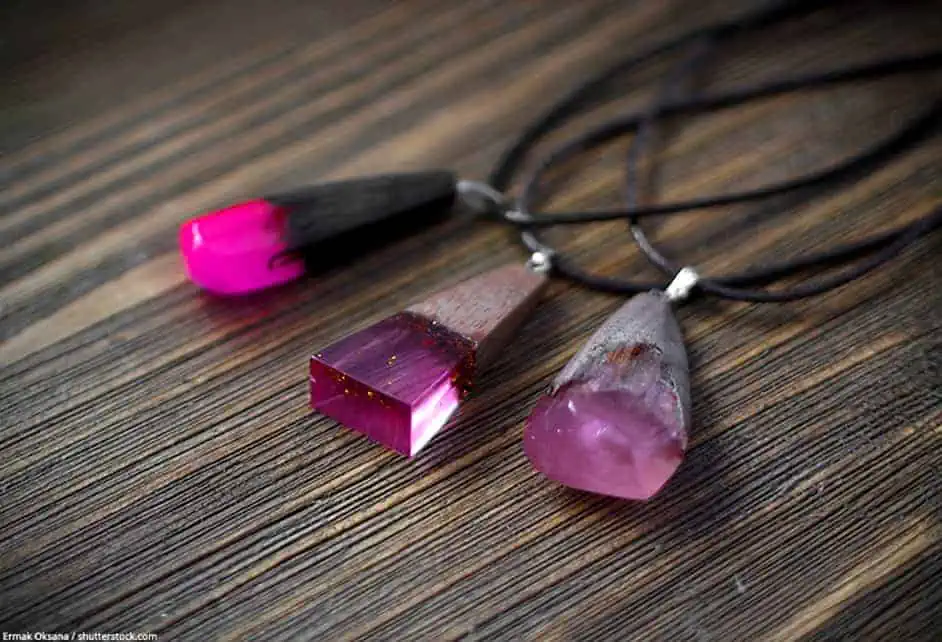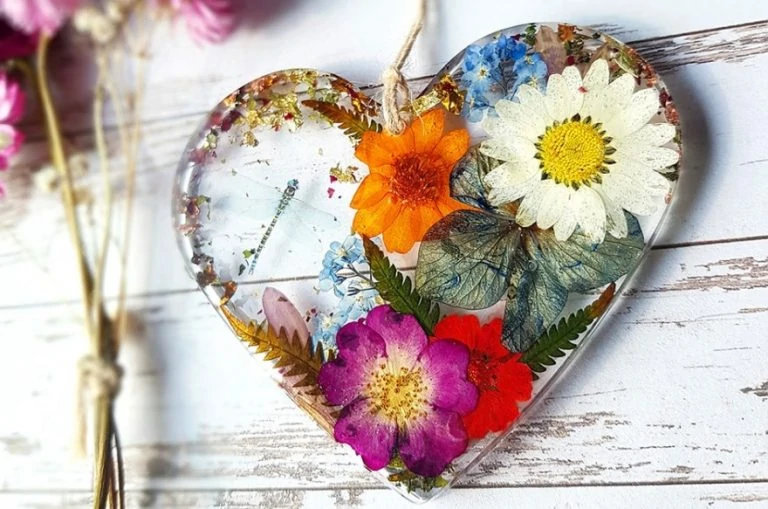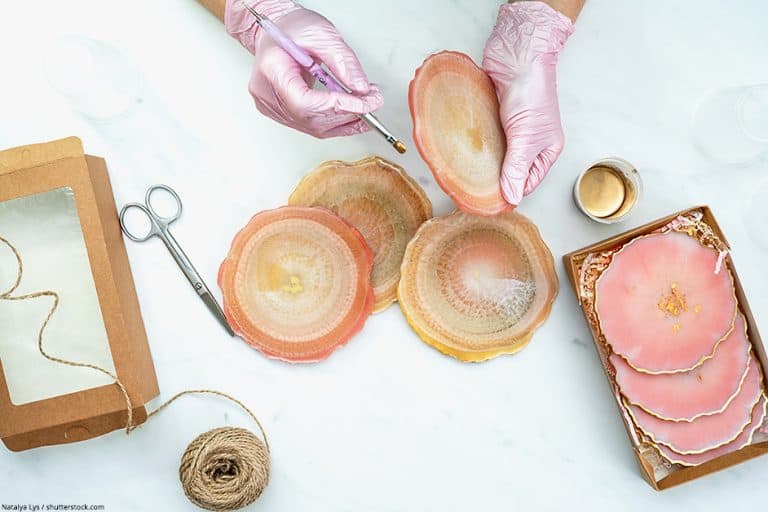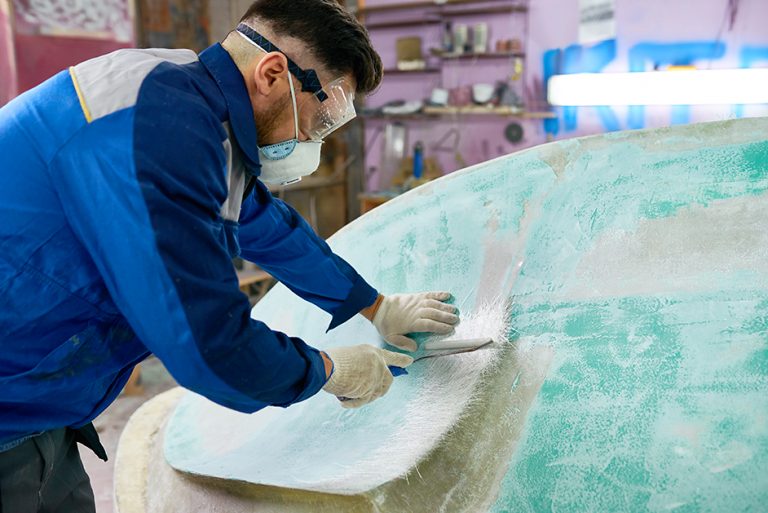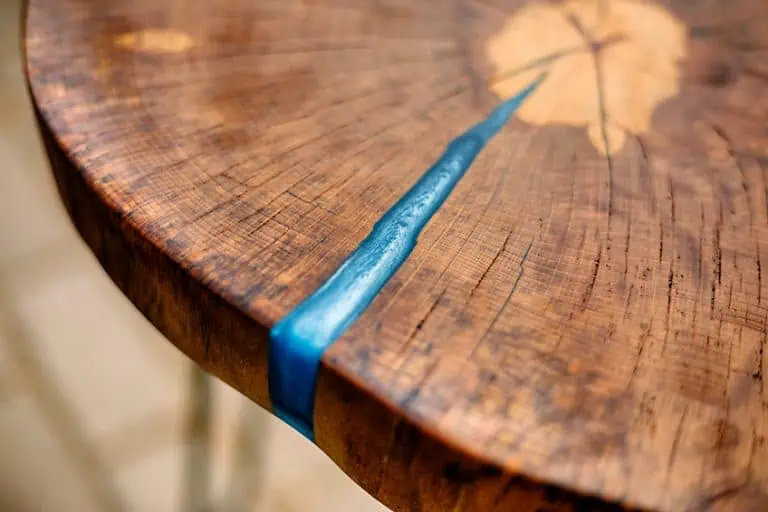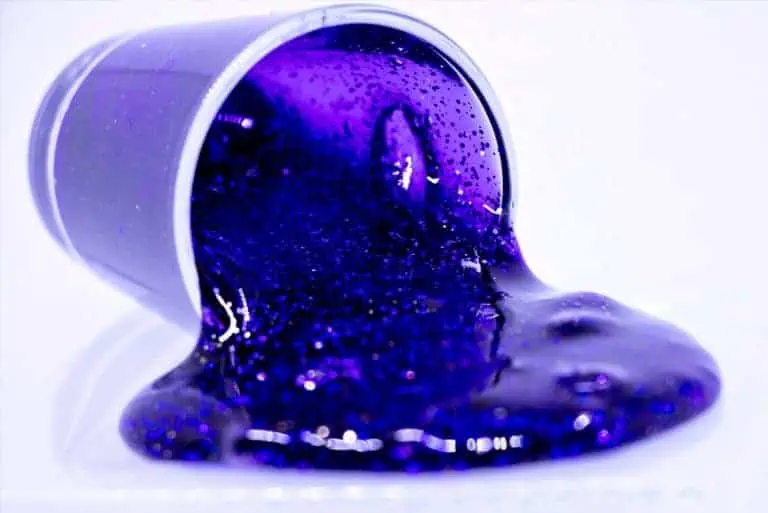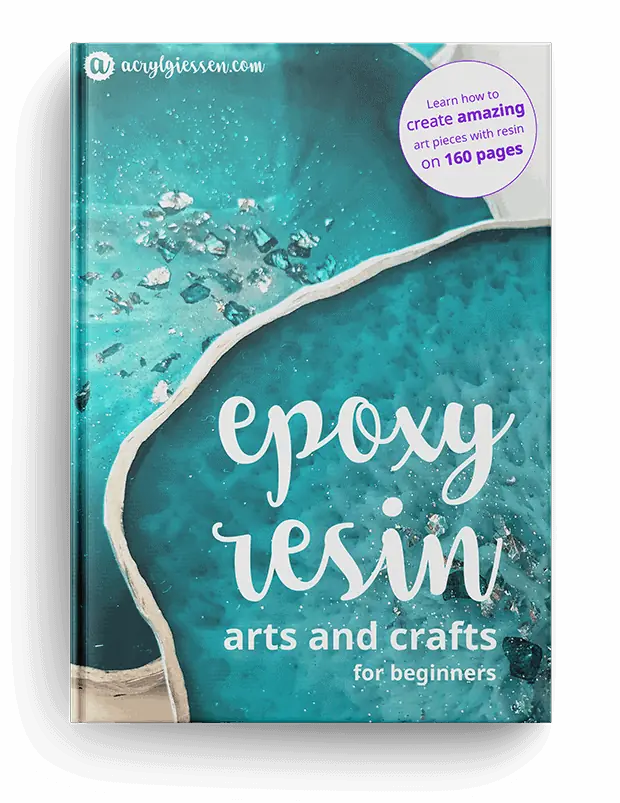How to Make Resin Jewelry – Tutorial and Best Resin for Jewelry
This post may contain affiliate links. We may earn a small commission from purchases made through them, at no additional cost to you.
Jewelry fans can easily create beautiful individual pieces themselves using epoxy resin. Due to the versatility of the synthetic resin, there are practically no limits to creativity in design. The crystal clear material becomes a real eye-catcher with small incorporated elements such as flowers, pearls or glitter particles. The following article provides valuable tips and tricks including instructions on how to make Resin Jewelry.
Table of Contents
- 1 Different Resins for Epoxy Jewelry
- 2 The Best Resin for Jewelry
- 3 Setting accents with Pigments and cast-in Elements
- 4 The best Resin Jewelry Molds
- 5 Other Materials you need to make your own Epoxy Jewelry
- 6 How to make Resin Jewelry – Step by Step Instructions
- 7 Common Problems with Resin Jewelry Making
- 8 Resin Jewelry Ideas
- 9 Frequently Asked Questions
Different Resins for Epoxy Jewelry
When using casting resin, you should know that not all resins are the same. There are sometimes considerable differences in the processing of the different types of resin. You can choose between epoxy resin, polyester resin or UV resin for the production of the workpiece. You can buy the resins online or in any well-stocked craft shop or DIY store.
Both epoxy and polyester resin must be mixed in the right proportion with an appropriate hardener to achieve an optimal result. To obtain this you should study the manufacturer’s instructions on the packaging thoroughly before you start. Often the mixing ratio has to be made to very different parts. The use of a measuring cup with a scale has proven to be a good method for this, as it allows you to work with high accuracy. A kitchen scale is also very helpful.
A perfect alternative for people for whom the exact measuring is too complicated is a casting resin with a mixing ratio of 1 : 1, where resin and hardener are simply mixed in equal parts. It is even easier with a UV resin, where no mixing with hardener is necessary at all.
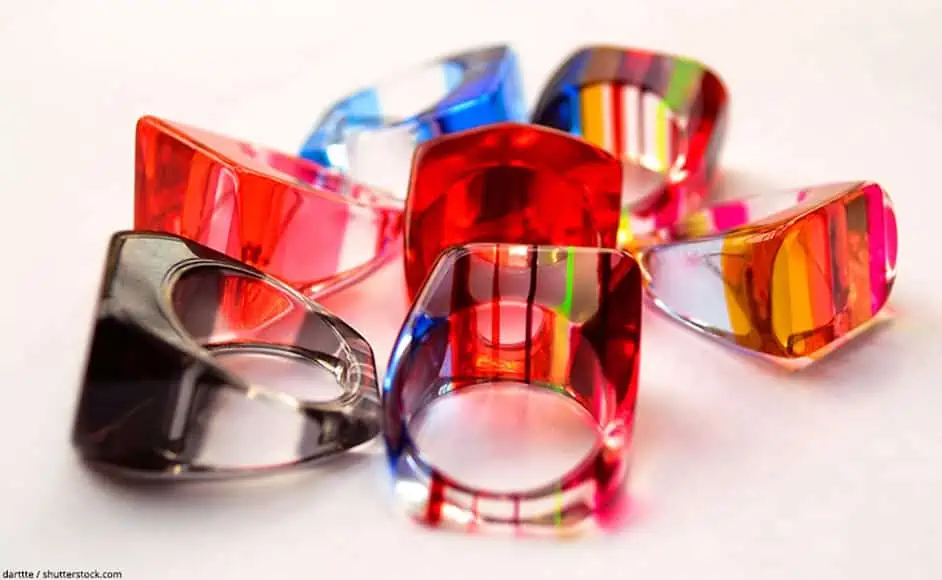
The Best Resin for Jewelry
Epoxy resin and polyester resin have two major differences: firstly, the appearance and secondly, the duration of the curing process. Also a suitable alternative: UV Resin. We show you here the best resin for jewelry making.
- Epoxy resin has a beautiful, crystal clear surface and is therefore ideal for the production of jewelry and accessories.
- Polyester resin dries very quickly and is also extremely robust. Therefore, this resin is primarily used for molded parts such as in boat building or for profile plates.
- For DIY enthusiasts who do not want to wait several days for the material to cure completely, a so-called UV resin is a perfect alternative. It does not have to be mixed with another component and cures completely under UV light using a special lamp within a few minutes. However, only relatively thin layers can be cast. However, since jewelry and accessories are usually quite small pieces, this should not be a problem.
These resins are best suited for the production of resin jewelry:
ProMarine Supplies ProArt Epoxy Resin
ProMarine’s ProArt Resin is made specifically to be used for art-related projects. You can protect all kinds of artwork, both fragile and robust, by coating it with the hard, crystal-clear finish of this resin. Use ProArt resin to make, secure, and protect art projects from drawings and paintings to woodwork and sculptures. This resin is best used on materials such as wood, metal, plastic, and canvas, and can be mixed with pigmented powders, dyes, and liquid tints to add a pop of color.
- Specifically designed for art projects, excellent color stability
- Very easy to use with 1 : 1 mixing ratio, 100% solids, hard-shell finish
- High gloss and crystal clear, your all-seal solution, excellent air release
PROS
- Affordable product of a high quality
- The finish is completely solid, similar to a hard shell
- Self-leveling resin with a very glossy finish
- Releases air well, thus preventing bubbles
- Very durable
- UV-resistant
- Minimal odor when working with
- Easy 1:1 mixing ratio
- Longer processing time to allow for more careful, precise work
CONS
- Slow curing time
Best Affordable Jewelers Resin:
- Super clear Table Top Epoxy for Wood
- Formulated for River Tables, Bar Tops and Countertops for hard surfaces
- Highest UV resistance, low VOC's and solvent free
Best UV Resin for Jewelry:
- High-quality UV Resin from Japan, developed with non-toxic materials
- High yellowing resistance, very hard surface after curing, anti-scratch, anti-stain
- UV epoxy resin with self-leveling properties cures a smooth crystal clear, glassy finish
Setting accents with Pigments and cast-in Elements
Pigments, flowers, glitter particles, small stones, shells, pearls, etc. – many materials are suitable for adding a special accent to epoxy resin. In order to get an idea in advance of how the selected element will ultimately work in the resin, however, if in doubt, a sample should first be made.
Since compact but small and light particles like glitter, mica flakes or small beads remain dimensionally stable in the resin, such elements are best suited for the production of epoxy resin jewelry. It is even easier if you mix them with the resin before casting. This is essential when using colors and pigments in the resin.
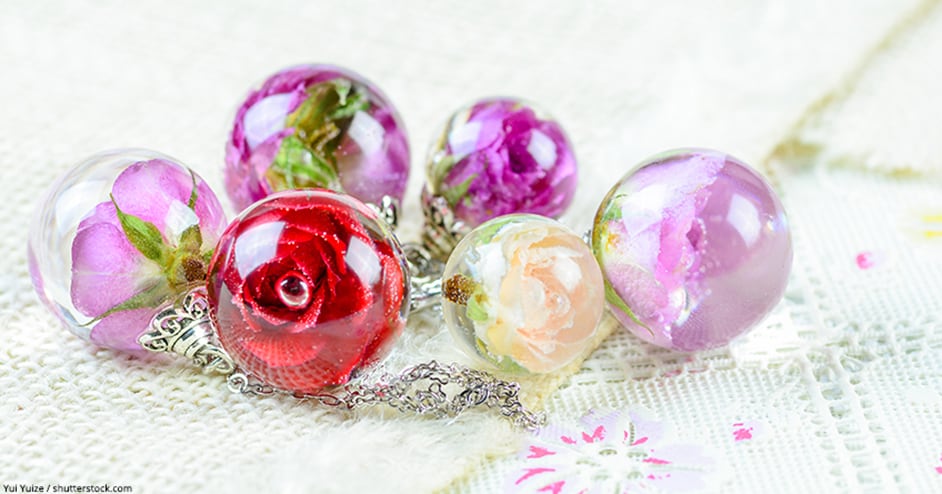
Heavier elements such as small stones and crystals sink quickly, especially in the very thin casting resin that is often used for the production of resin jewelry and accessories. Therefore such objects have to be cast between the individual resin layers.
Very fragile objects such as dried flowers must be placed with extreme care on a resin layer while it is still wet. If you do not work with enough dexterity here, the elements as such are not visible in the resin, but only form unsightly lumps. A steady hand or sealing the object with a little napkin glue in advance can help here.
- Set contains 18 opaque liquid colorants for epoxy resin
- Non-toxic and odorless in transparent 0.35 ounce bottles
- Concentrated and easy to use for achieving solid colors in resin
- Add decorative stones to add shimmering or realistic accents to your resin paintings
- Weight: 2 pounds, about 1000 gram., stone size: 1 – 3 mm
- Material: glass sand, Volume: 0.22 gallons, colorfast, non-toxic
The best Resin Jewelry Molds
Especially in the field of jewelry and accessories, you will find a variety of pre-fabricated silicone molds, which allow DIY fans a very simple introduction to resin jewelry making. From pendants to finger rings to ear studs, everyone will find the right shape for themselves.
Our recommendations on polished resin molds for beautiful epoxy resin jewelry:
- High quality silicone jewelry mold starter set
- Molds for bracelets, necklace and earring pendants, and rings
- Suitable for casting, and UV resins, but not for coating resin
- All molds come in pairs to allow casting at the same time
- Set includes molds, earring hooks, jump rings, and head/eye pins
- Smooth high quality silicone for easy demolding
Other Materials you need to make your own Epoxy Jewelry
- Mixing Cups
- Heat Gun or Butane Torch
- Toothpicks
- Mini Hand Drill
- Sandpaper or Micro Mesh
- Nitrile Gloves
- Respirator Mask
- Safety Glasses
- Plastic Drop Cloth
How to make Resin Jewelry – Step by Step Instructions
Step 1: Preparations before making Resin Jewelry
Once you have decided which resin jewelry or accessory you want to make, the first step is to choose a suitable silicone mold. Then you should at least roughly estimate how much resin you will need to fill the mold.
Now mix about half of the calculated value and color it in if necessary. Then you can pour the resin into the mold. If you are unsure about the quantity of resin you need, use our epoxy calculator.
Step 2: Pour the Epoxy Resin into the Silicone Mold
- As mentioned above, small, light elements are placed in the still liquid resin.
- Afterward, you should give the resin at least 24 hours to dry (or as long as the manufacturer recommends on the packaging).
- If you also want to include larger, heavier elements in your work, you can position them on the first layer of cast resin after it has hardened. To prevent the objects from slipping during further casting, you can fix them with some resin.
- Once the large elements are securely fixed, the rest of the silicone mold can be filled with the resin. Now the whole thing must dry completely. The manufacturer’s instructions provide information on the duration of the curing process.
Tip: If air bubbles have formed in the resin layer during casting, you can easily remove them with a short, light swing of a Bunsen burner or hot-air blow-dryer over the resin.
Step 3: Demolding the Resin Jewelry from the Mold
The exact curing time of the casting resin can vary from manufacturer to manufacturer. You will find information on the packaging. Usually, after about 48 hours the workpiece is cured enough to be removed from the mold. Be careful not to injure yourself on any sharp edges on the underside of the casting when removing it.
Step 4: The Finishing Touches to Epoxy Resin Jewelry
If sharp edges have actually formed during curing, these can be easily removed with fine-grained sandpaper. Polishing paste and a soft cloth give the piece of jewelry a beautiful shine. This is often missing if a conventional silicone mold was used during production. Find more about epoxy resin polishing.
Crystal clear resins or glossy lacquers are also suitable as a finish to achieve the radiant effect. However, you can save yourself this further processing if you use a polished silicone mold directly. The smooth inner surface guarantees you an absolutely perfect, even surface of your epoxy resin jewelry.
You can easily learn about how to make resin jewelry from home. There are numerous books and online information on the subject, but it will take quite a bit of trial and error before you gain enough experience to create a perfect resin item. Remember, always wear protective gear.
Common Problems with Resin Jewelry Making
Let’s have a look at a few problems that might occur when making your resin jewelry. We will also be looking at a few common questions people ask about resin jewelry making.
Embedded Flowers in Resin may turn yellow, lose Color and Wither
If flowers are not treated properly before embedding into the resin, they will slowly fade, turn brown or yellow over time. To keep the flowers looking fresh, it is best to first dry them and then treat them with ultraviolet lacquer. You can also add a bit of same color paint to the flowers to keep them looking fresh. Following the correct procedures when embedding flowers in resin jewelry is the only way to keep their shape and color.
Handmade Resin Jewelry tends to produce Bubbles
During the mixing process of the resin with the hardener, you will produce bubbles in your mixture. To remove bubbles, you can use a pressure pot or degasser. This might be best for somebody who is continually creating resin items, as the equipment is expensive. For the beginner or part-time hobbyist, it might be a better option to use a torch gun, or even a toothpick to get rid of bubbles.
Resin Products can be harmful in Fluid State
When the resin is still in its fluid state and while mixing it, it can release harmful fumes. Once the resin is fully cured, it is non-toxic. Check that your epoxy does not have any Bisphenol A and is certified food grade by the FDA. In all cases, when working with epoxy resin, it is advisable to wear protective gear like gloves and a mask. Your work area should also be well ventilated and preferably in a separate room. When it comes to food, have a look at our Food Safe Epoxy article for more details.
Resin can turn yellow over Time
Most resin will eventually turn yellow over time, especially if exposed to sunlight often. The quality of your resin as well as adding a UV filter or stabilizer will lengthen the time it takes for this to happen.
Resin Jewelry Ideas
There is a wide range of resin jewelry you can craft, here is a short list to give you an impression:
- Earrings
- Hairpins
- Necklaces
- Bracelets
- Hand Rings
- Amulets
Frequently Asked Questions
How to Make Resin Jewelry with Dried Flowers?
First, you have to dry the flowers with silicate sand. The alternative: buy the already dried flowers or botanical pieces so you can start right away. Pour a little bit of epoxy resin into a jewelry mold and place the flower in it. Then fill up the resin jewelry mold with resin and wait until the piece is dried. We have a step-by-step tutorial for making your resin jewelry with flowers.
Is Resin Safe for Jewelry?
Epoxy Resin, developed for use with jewelry is nontoxic after the curing is done. You can always ask the manufacturer of your Resin to find out how safe his product is for wearing as jewelry.
How to make Wood and Resin Jewelry?
Resin jewelry that combines the materials epoxy resin and wood looks particularly luxurious and individual. But the production of such epoxy resin jewelry is a bit more complex. First, one or more pieces of wood are placed in a (usually rectangular) silicone mold or a self-made mold. Then the mold is filled with the casting resin. The effect is especially beautiful if the resin is colored before casting. When the blank is completely hardened, it can be removed from the mold and then further processed. You can now cut it into the shape you want, then sand it down and polish it to the finish.
The making of jewelry from wood and resin is a bit more complex and requires a little more craftsmanship, but with a little practice it is easier than you think.
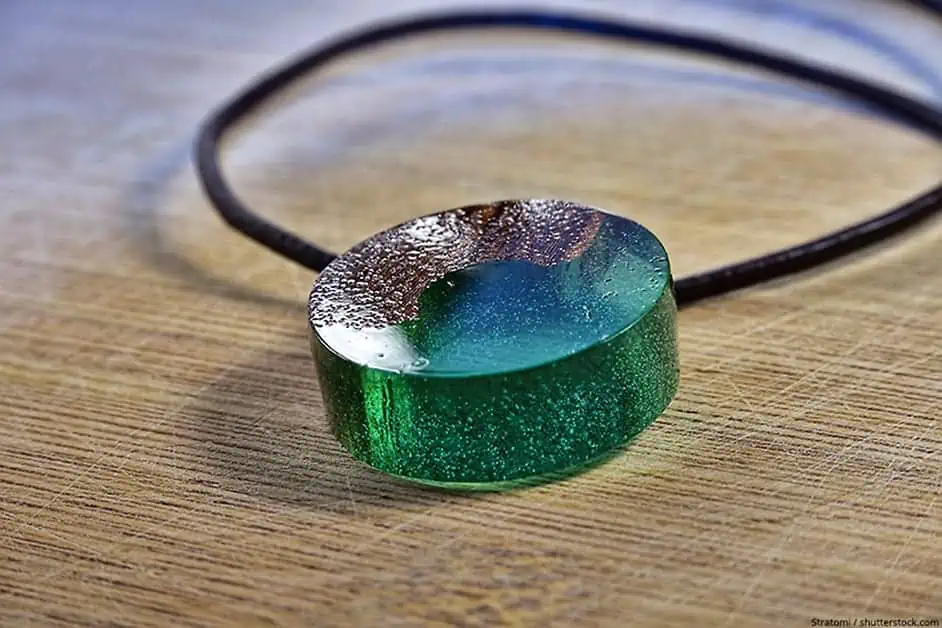
Is Resin Jewelry waterproof?
Yes, resin jewelry is waterproof. Since the metals used in making the jewelry can get damaged, it is preferable if you remove any jewelry when showering, swimming, or working with water in any way.
How long does Resin Jewelry last?
Resin jewelry can last an exceptionally long time, it is best to avoid exposing the jewelry to high temperatures and you need to take care of it appropriately.
Is Resin Jewelry harmful?
The final hardened or cured resin jewelry piece is non-toxic. The risk lies when the resin is still in liquid form where it can release harmful fumes. If you are unsure, always choose an epoxy that is certified food grade for your resin jewelry.
Is Resin Jewelry safe for Children?
Once cured and the resin goes hard, it is safe for children as well as pregnant women to wear. An epoxy coating, on the other hand, which overlays a concrete floor is also quite safe for children and everybody else including your pets, once hardened. Nonetheless, some might be allergic to the epoxy coating. To wrap up with resin jewelry making, it is one of the best ways to work with resin as a crafter. The process is quite simple and easy to do, as long as you follow the instructions properly. To get a long-lasting, beautiful resin jewelry piece, remember to sand and polish for the perfect look.
In 2005, Charlene completed her wellness degrees in therapeutic aromatherapy and reflexology at the International School of Reflexology and Meridian Therapy. She worked for a company offering corporate wellness programs for several years before opening her own therapy practice. In 2015, she was asked by a digital marketer friend to join her company as a content creator, and it was here that she discovered her enthusiasm for writing. Since entering the world of content creation, she has gained a lot of experience over the years writing about various topics such as beauty, health, wellness, travel, crafting, and much more. Due to various circumstances, she had to give up her therapy practice and now works as a freelance writer. Since she is a very creative person and as a balance to writing likes to be active in various areas of art and crafts, the activity at acrylgiessen.com is perfect for her to contribute their knowledge and experience in various creative topics.
Learn more about Charlene Lewis and about us.
